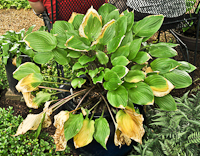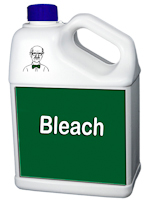|
 |
|
 |
|
 |
|
 |
 |
 Also known as crown rot
and white mold, Southern blight is a disease caused by
the fungus, Sclerotium rolfsii.
As the name implies, this was once a problem primarily
in the hot, humid south but has recently been moving
into the upper Midwest (global warming?). Also known as crown rot
and white mold, Southern blight is a disease caused by
the fungus, Sclerotium rolfsii.
As the name implies, this was once a problem primarily
in the hot, humid south but has recently been moving
into the upper Midwest (global warming?).
There are over 200
different genera of plants that are susceptible to this
disease. In the home landscape, common hosts would
include
daylily,
astilbe,
hostas,
peony,
phlox,
ajuga, and
delphinium.
|
 |
|
 |
 |
Although its symptoms can
be similar to other diseases, the first signs of
Southern blight would include yellowing of foliage and
wilting of leaves. This disease attacks at or just below
the soil line so there may be black or dark brown
lesions on the lowest part of the stem. In
hosta, it may
appear as a brown rot at the base of the leaf petioles.
One of the best
characteristics for identification is the development of
cottony white, threadlike wisps called mycelium that
grow up the stem and may spread out on top of the soil.
The fungus overwinters as
a very small, brown or tan colored structure called the
sclerotia. These can be found on the surface of the soil
near infected plants. It was thought that the reason the
disease was found mostly in the South was that these
structures could not survive the winter cold up North.
However, it appears that they can live as long as they
are covered by a layer of snow or organic mulch.
A related disease, white
mold caused by a relative fungus, Sclerotinia
sclerotiorum, is quite similar. It seems that the
distinguishing feature is that the sclerotia of this
disease are larger (about the size of small rabbit
droppings) and they are usually attached to the lower
stem of infected plants.
|
 |
 |
 |
Perhaps the best way to
deal with Southern blight is to be aware of which plants
are susceptible and, if you have been having a problem
with this disease in your landscape, avoid planting
these to replace lost plants.
|
 |
 |
 |
 Since this is a soil borne
fungus, once it is present in your landscape, it is very
difficult to eliminate. To do so would require sterilization
of the soil and that is a tough task. Some commercial pest
control companies may have specialized equipment and access
to potent chemicals that can sterilize large amounts of soil
in the garden. Since this is a soil borne
fungus, once it is present in your landscape, it is very
difficult to eliminate. To do so would require sterilization
of the soil and that is a tough task. Some commercial pest
control companies may have specialized equipment and access
to potent chemicals that can sterilize large amounts of soil
in the garden.
Some home gardeners have tried treating small areas around
where
herbaceous perennials have died with this disease.
They have used a dilute solution of chlorine bleach (one
part bleach to nine parts water) to treat the soil before
replanting.
|
|
 |
|
Note: We
have provided some general information and
observations on this topic aimed at the home
gardener. Before you take
any serious action in your landscape, check
with your state's land grant university's
Cooperative
Extension
Service for the most current,
appropriate, localized recommendations. |
|
 |
 |
 |
Some plants susceptible to Southern blight (Scleratium
rolfsii):
*Southern blight has been reported on hundreds of plants.
This is a partial list of plants that are frequently
infected by this disease.
|
|
|
 |
|



